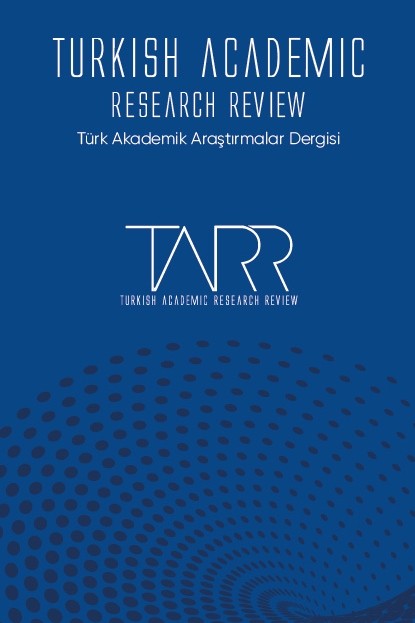İbn Kesîr’in Tefsirinde Rivayet Kullanımı
Tefsir tarihinde içerdikleri malzemenin ‘nakil olması’ dolayısıyla ‘rivayet tefsiri’ kategorisine dâhil edilen eserlerin her birinin kendine özgü üslup ve yöntemleri vardır. Söz konusu eserlerin üslup ve yöntemlerine ilişkin tahliller, dâhil oldukları alana katkılarını ortaya koymak açısından önem arz etmektedir. Makalede İbn Kesîr’in, Tefsîru’l-Kur’âni’l-azîm adlı eserinde rivayet kullanımına ilişkin yöntem ve uygulamalarının tahlili amaçlanmıştır. Zira tefsirde istihdam edilen rivayet türleri ve bu rivayetlerin nakledilişindeki biçimsel farklılaşmalarda düşünsel bir arkaplan mevcuttur. Kur’an tefsirinde en iyi yöntemin sırasıyla Kur’an’ın Kur’anla, sünnetle, sahabe ve tâbiun sözleriyle tefsir olduğunu düşünen İbn Kesîr’in tefsirinde yer verdiği malzeme bu düşüncesiyle örtüşmektedir. Bu noktada İbn Kesîr tefsiri, genel yapısı itibarıyla tefsiri nakille sınırlandıran rivayet tefsiri geleneğinin çizgisinde bir yönteme sahiptir. Kur’an’dan sonra ikinci kaynak olarak işaret ettiği “sünnet”e ilişkin bilgiyi içeren rivayetlere yer vermesi ise rivayet tefsiri geleneğinden yöntem olarak ayrıldığı en önemli noktadır. İbn Kesîr bu uygulamasıyla, ilk dönemlerde Hz. Peygamber’in doğrudan ayetlere ilişkin açıklamalarını nakleden rivayet tefsirlerinden farklı olarak ayetlerle doğrudan ilişkisi olmayan haberleri yani sebeb-i vürûdu Kur’an tefsiri olmayan rivayetleri kendi ifadesiyle ‘sünneti’ de tefsirin kaynağına dâhil etmiştir. Bu durum hadisçi bakışın tefsir literatürüne etkisini de örneklemektedir.
The Use Of Narration (Al-Riwayah) In Ibn Kathir’s Tafsir
In the history of tafsir, each of the studies which is involved in the tafsir bi al-riwayah by reason of the conveyance of the material that the studies contain has the unique wording and methods. The analyses which is associated with the wording and methods of these studies play a significant role in the contribution to the field in which the analyses are involved. In this article, It is aimed at analysing the methods and implemantation which is linked to the use of narration in that the study is named for Tefsiru’l-Kur’ani’l-‘azîm of Ibn Kathir. As, in the tafsir there is an intellectual background in a variety of the narrations which is structured and the stylistic differentiation which is involved the methods of the conveyance of this narrations. Ibn Kathir’s view is that in the commentary of the Quran, the proper method is that the Quran is the commentary with the Quran, al-sunnah, compenions and the statement of tabiun respectively and the material that is involved in the commentary of İbn Kathir coincides with this notion. In this respect, the tafsir of Ibn Kathir in terms of this general construction has a method a line at the tradition of the commentary of narration which is stricted the commentary to the conveyance. On the grounds of, the Tafsir of Ibn Kathir refers to the narrations which contain information about al-sunnah, the second source after the Quran, it is the most important point that this tafsir is separated from the tradition of the tafsir bi al-riwayah as a method. İbn Kathir, with this implementation, in the early periods as distinct from the commentary of narration which clearly and directly convey The Prophet’s statements about the verses, incorporates news which are not directly related to the verses in other words sabab al-wurud, the narration which is not the commentary of the Quran and of his own statement al-sunnah as well into the source of the commentary. This situation exemplifies that the approach of muhaddis has a noticeable effect on literature of the commentary at the same time.
___
- el-Begavî, Ebû Muhammed el-Hüseyn b. Mes‘ûd, Me‘âlimu’t-tenzîl, thk. Muhammed Abdullah en-Nemr-Osman Cuma Damîrî-Süleyman Müslim el-Harş. B.y.: Dâru Tayyibe, IV. Baskı, 1997.
- el-Kurtubî, Ebû Abdullah Muhammed b. Ahmed b. Ebû Bekir. el-Câmi‘ li ahkâmi’l-Kur’an, thk. Hişâm Semîr el-Buhârî, Riyad: Dâru’l-âlemi’l-kütüb, 2003.
- es-Sa‘lebî, Ebû İshâk Ahmed b. Muhammed b. İbrâhîm. el-Keşf ve’l-beyân. thk. Muhammed b. Âşûr. Beyrut: Dâru ihyâi’t-türâsi’l-arabî, 1422/2002.
- es-Semerkandî, Ebü’l-Leys Nasr b. Muhammed b. İbrahim. Bahru’l-ulûm, thk: Dr. Mahmud Matracî, Beyrut: Daru’l-fiker, ts.
- eş-Şâfiî. Ebû Abdillah Muhammed b. İdrîs. el-Üm. Beyrut: Dâru’l-ma‘rife, 1410/1990. ______.
- er-Risâle, thk. Ahmed Şâkir. Kahire: Mektebetü’l-Halebî, 1358/1940.
- et-Taberî, Ebû Cafer Muhammed b. Cerîr. Câmiu’l-beyân fî te’vîli’l-Kur’ân, thk. Ahmed Muhammed Şakir, Müessesetü’r-Risâle, 2000.
- İbn Ebî Hâtim, Ebû Muhammed Abdurrahman. Tefsîru’l-Kur’ani’l-Azîm musneden ‘an rasûlillahi ve’s-sahâbeti ve’t-tâbi’în, thk. Es’ad Muhammed et-Tayyib, B.y: el-Mektebetu’l-asriyye, ts.
- İbn Hacer, Ebü’l-Fadl Ahmed b. Ali, Nuzhetu’n-nazar fî tavdîhi nuhbeti’l-fiker fî mustalahi ehli’l-eser, thk. Abdullah b. Dayfillah er-Rahîlî, Riyad: Matbaatü sefîr, 1422.
- İbn Hazm, Ebû Muhammed Ali b. Ahmed. el-İhkâm fî usûli’l-ahkâm. thk. Ahmed Muhammed Şâkir. Beyrut: Dâru’l-âfâki’l-cedîde, ts.
- İbn Kesîr, Ebül-Fidâ İsmâil b. Ömer b. Kesîr el-Kuraşî ed-Dımeşkî. Tefsîrul-Kur’âni’l-Azîm. Lübnan-Beyrut: Daru’l-Ma’rife, 1986.________, Tefsîru’l-Kur’ani’l-azîm, thk. Sami b. Muhammed Selâme, B.y.: Dâru Tayyibe, II. Baskı, 1999.
- İbn Teymiye, Takıyyüddîn Ebü’l-Abbâs Ahmed b. Teymiyye. Mukaddime fî usûli’t-tefsîr, Dımeşk, 1355/1936.
- Müslim, Ebû Hüseyn b. Haccâc el-Kuşeyrî, el-Câmiu’s-sahîh, thk. Muhammed Fuâd Abdülbâkî, Beyrut: Dâru ihyâi’t-türâsi’l-arabî, ts.
- Türcan, Zişan, “Sünnetin Kaynağına Dair Tasavvurların Dönüşümü”, e-Şarkiyat İlmi Araştırmalar Dergisi, (Nisan 2019), cilt: 11, sayı: 1 (23), 242-262.
- ______, Zişan. “Üçüncü Asır Hadis Musennafâtı Üzerinde eş-Şâfiî’nin Etkisi”, Hadis Tetkikleri Dergisi, c. VII/1, 2009.
